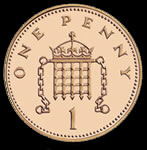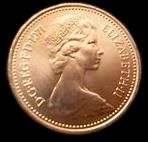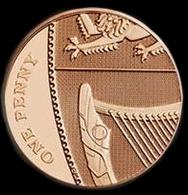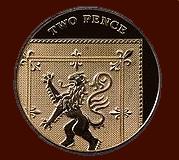








Designed by Nigel G Wilcox






The Paragon Of Metal Detecting
Powered By Sispro1
One Penny

The British decimal one penny (1p) coin, produced by the Royal Mint, was issued on 15 February 1971, the day the British currency was decimalised . In practice, it had been available from banks in bags of 1 for some weeks previously. The coin, known at first as a "new penny", was initially minted from bronze, but since 1992 it has been minted in copper -plated steel. As this is less dense than bronze, post-1992 coins have been slightly thicker, as well as becoming magnetic. The coin weighs 3.56 grams (approximately one eighth of an ounce and has a diameter of 20.32 millimetres.
The penny is one hundredth fraction of a pound: one hundred pence sterling is one pound sterling.
One penny and two pence coins are legal tender only up to the sum of 20p; this means that it is permissible to refuse payment of sums greater than this amount in 1p and 2p coins in order to settle a debt.
As of March 2008 there were an estimated 10,900 million 1p coins in circulation.
Soaring copper prices in the mid-2000s caused the value of the copper in the pre-1992 coins (which are 97% copper) to exceed the coins' face value. For example, in May 2006, the intrinsic metal value of a pre-1992 1p coin was about 1.5 pence.During 2008, the value of copper fell dramatically from these peaks
The penny is one hundredth fraction of a pound: one hundred pence sterling is one pound sterling.
One penny and two pence coins are legal tender only up to the sum of 20p; this means that it is permissible to refuse payment of sums greater than this amount in 1p and 2p coins in order to settle a debt.
As of March 2008 there were an estimated 10,900 million 1p coins in circulation.
Soaring copper prices in the mid-2000s caused the value of the copper in the pre-1992 coins (which are 97% copper) to exceed the coins' face value. For example, in May 2006, the intrinsic metal value of a pre-1992 1p coin was about 1.5 pence.During 2008, the value of copper fell dramatically from these peaks
British Decimal Currency - Numismatics,
One Pence 1p
For Reference ONLY
Everything For The Detectorist
Copyright All Rights Reserved by Nigel G Wilcox E-Mail: ngwilcox100@gmail.com
6. Menu
Pages


Main Coin Menu
Decimal Coin Menu
Member NCMD























